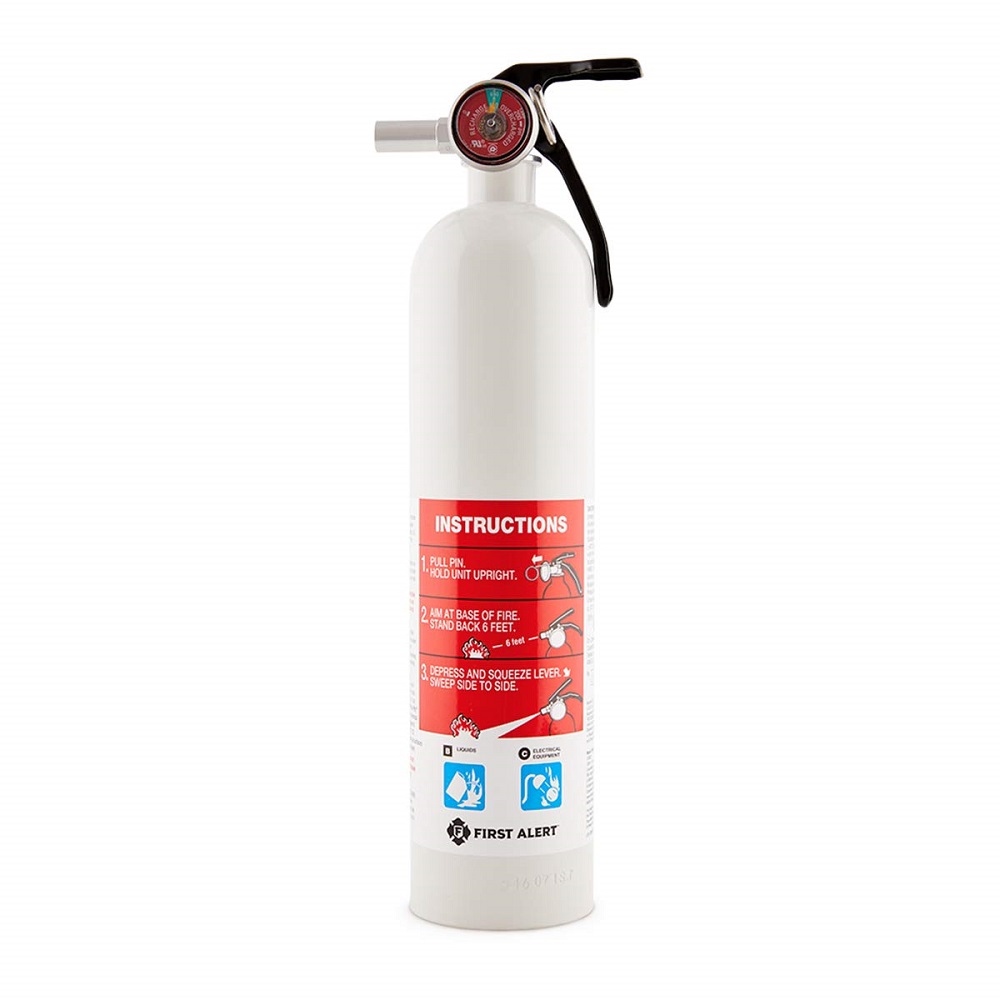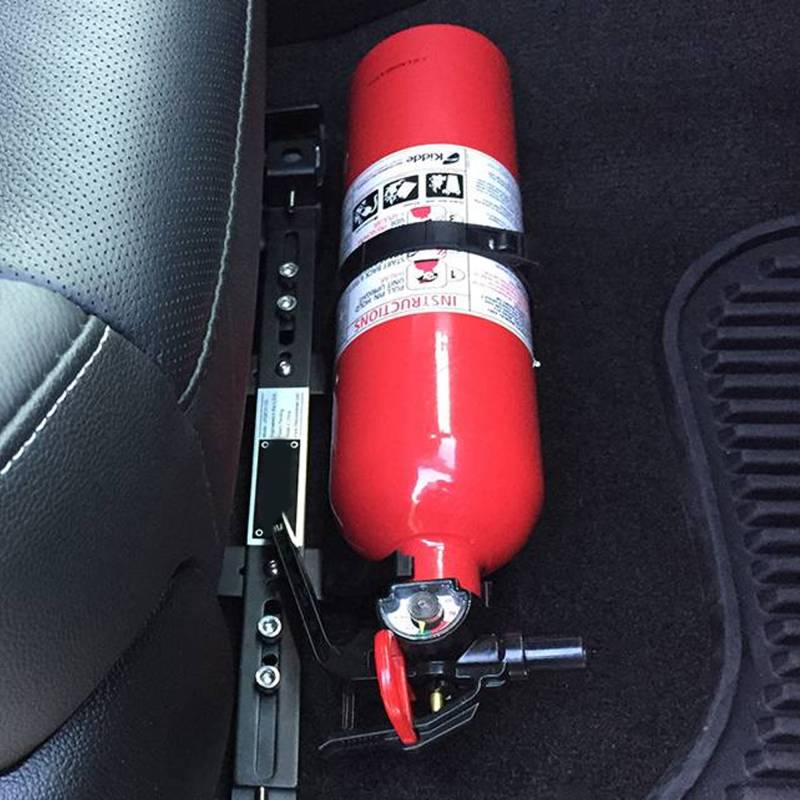Car fires, though rare, can occur unexpectedly and pose significant dangers. Being prepared with the right tools and knowledge can make all the difference in an emergency. A car fire extinguisher is an essential safety device that can help you control or extinguish a fire before it escalates. This guide provides comprehensive instructions on how to safely use a car fire extinguisher during emergencies, ensuring you and your passengers remain safe.
Understanding Car Fire Extinguishers
Before you can effectively use a car fire extinguisher, it’s important to understand what they are and how they function.
What is a Car Fire Extinguisher?
A car fire extinguisher is a compact, portable device designed to suppress small fires in vehicles. These extinguishers are specifically formulated to handle common types of car fires, such as those caused by electrical malfunctions, fuel leaks, or overheated engines. They typically use agents like foam, CO₂, or dry chemical powders to extinguish flames quickly and efficiently.
How Car Fire Extinguishers Work
Car fire extinguishers operate by cutting off the fire’s oxygen supply, cooling the burning material, or disrupting the chemical reaction that sustains the fire. Depending on the type of extinguisher, different agents are released to tackle various fire classes:
- Class A: Fires involving ordinary combustibles like wood or fabric.
- Class B: Fires involving flammable liquids such as gasoline or oil.
- Class C: Fires involving electrical equipment.
- Class D: Fires involving combustible metals (less common in cars).
- Class K: Fires involving cooking oils and fats (rare in vehicles).
Most car fire extinguishers are rated for Class B and C fires, making them suitable for handling vehicle-related emergencies.

Types of Car Fire Extinguishers
Choosing the right type of fire extinguisher for your car is crucial for effective fire management. Here are the most common types available:
Dry Chemical Extinguishers
Dry chemical extinguishers are versatile and effective against Class A, B, and C fires. They release a fine powder that blankets the fire, interrupting the chemical reaction. These extinguishers are popular in cars due to their effectiveness and versatility.
CO₂ (Carbon Dioxide) Extinguishers
CO₂ extinguishers are ideal for electrical fires (Class C) as they discharge a cloud of carbon dioxide, which displaces oxygen and smothers the flames. They leave no residue, making them suitable for use around sensitive electronic equipment in vehicles.
Foam Extinguishers
Foam extinguishers work by forming a blanket over flammable liquids, cutting off the oxygen supply and cooling the fuel. They are highly effective for Class B fires and can also handle some Class A fires. However, they may not be as effective on electrical fires compared to dry chemical extinguishers.
Wet Chemical Extinguishers
While not commonly required in cars, wet chemical extinguishers are designed for Class K fires involving cooking oils and fats. They might be useful in specific situations but are generally unnecessary for most vehicles.
Choosing the Right Fire Extinguisher for Your Car
Selecting the appropriate fire extinguisher ensures you are prepared for potential vehicle fires. Here are factors to consider:
Size and Portability
Car fire extinguishers come in various sizes, typically ranging from 2 to 5 pounds. A smaller extinguisher (2-5 pounds) is usually sufficient for most cars, as it is easy to store and handle during an emergency.
Rating and Certification
Ensure the fire extinguisher is rated for automotive use, specifically suitable for Class B and C fires. Look for certifications from recognized organizations like UL (Underwriters Laboratories) or ANSI (American National Standards Institute), which confirm the extinguisher meets safety and performance standards.
Ease of Use
Choose a fire extinguisher with clear instructions and an easy-to-grip handle. Training yourself and any passengers on how to use the extinguisher can significantly improve effectiveness during an emergency.
Maintenance and Expiry
Select an extinguisher that is easy to maintain and regularly check its pressure gauge and expiration date. Fire extinguishers typically need to be replaced or serviced every five years, depending on the manufacturer’s recommendations.

How to Use a Fire Extinguisher Safely
Proper usage of a fire extinguisher is essential to avoid injury and effectively manage the fire. Follow these safety guidelines:
Safety First
Before attempting to use a fire extinguisher, ensure your safety and that of your passengers. If the fire is too large or spreading rapidly, evacuate the vehicle immediately and call emergency services.
Read the Instructions
Familiarize yourself with the PASS technique, which stands for Pull, Aim, Squeeze, and Sweep. Most extinguishers come with clear instructions labeled on the device.
Maintain a Safe Distance
Stand at a safe distance from the fire, typically about 6-8 feet away. This distance allows you to control the extinguisher without getting too close to the flames.
Protect Yourself
Wear protective gear if available, such as gloves and safety glasses, to shield yourself from heat, smoke, and debris.
Step-by-Step Guide to Using a Fire Extinguisher in Your Car
In an emergency, knowing the precise steps to use a fire extinguisher can save valuable time and prevent the fire from spreading. Follow these steps:
Step 1: Assess the Situation
Quickly evaluate the size and location of the fire. Determine if it’s safe to attempt extinguishing it. If the fire is small and contained, proceed with using the extinguisher. Otherwise, evacuate and call for help.
Step 2: Retrieve the Extinguisher
Locate your car fire extinguisher, typically stored in the trunk, under the seat, or in a designated storage compartment. Ensure it is easily accessible and not obstructed by other items.
Step 3: Pull the Pin
Remove the safety pin on the extinguisher. This action allows you to discharge the extinguishing agent. Be ready to act quickly once the pin is pulled.
Step 4: Aim at the Base
Point the nozzle or hose at the base of the fire, not at the flames. Targeting the source of the fire helps to smother and extinguish it more effectively.
Step 5: Squeeze the Handle
Firmly squeeze the handle or lever to release the extinguishing agent. Maintain a steady pressure to ensure a continuous flow until the fire is fully out.
Step 6: Sweep Side to Side
Use a sweeping motion across the base of the fire, covering the entire area evenly. This technique ensures that the extinguishing agent is distributed effectively to suppress the flames.
Step 7: Monitor and Evacuate if Necessary
After extinguishing the fire, continue to monitor the area for any signs of re-ignition. If the fire flares up again or you’re unsure if it’s completely out, evacuate the vehicle and call emergency services.

Maintenance and Inspection of Car Fire Extinguishers
Regular maintenance and inspection of your car fire extinguisher ensure it remains ready for use during emergencies. Here are key maintenance practices:
Monthly Checks
Perform a quick visual inspection monthly to ensure the extinguisher is in good condition. Check for any signs of damage, rust, or tampering. Ensure the pressure gauge is in the green zone, indicating adequate pressure.
Annual Servicing
Have your fire extinguisher professionally serviced at least once a year. A professional inspection can identify any internal issues and ensure that the extinguisher meets safety standards. Replace components or the entire extinguisher if necessary.
Proper Storage
Store the extinguisher in its designated place, ensuring it is easily accessible in an emergency. Avoid places where the extinguisher might be exposed to extreme temperatures or moisture, which can degrade its effectiveness.
Recharging After Use
If you use the extinguisher, have it professionally recharged before the next use. An exhausted extinguisher is no longer reliable and must be refilled or replaced according to the manufacturer’s guidelines.
Additional Safety Tips and Precautions
Enhancing your overall safety measures can prevent car fires and ensure you’re prepared to handle them effectively.
Preventive Measures
Taking preventive steps can reduce the risk of car fires:
- Regularly inspect your vehicle’s electrical system for any signs of wear or damage.
- Avoid overloading electrical outlets with multiple devices.
- Ensure that fuel lines and connections are secure and free from leaks.
- Maintain proper engine upkeep to prevent overheating.
Emergency Preparedness
Being prepared for emergencies enhances your ability to respond effectively:
- Keep a first aid kit and emergency supplies in your car alongside the fire extinguisher.
- Familiarize yourself and your passengers with the location and operation of the extinguisher.
- Practice the PASS technique drills to ensure everyone knows how to act in case of a fire.
Evacuation Plan
Developing and knowing an evacuation plan can save lives:
- Identify the quickest exits from your vehicle in case of fire.
- Ensure all passengers understand the evacuation procedures.
- Keep calm and act swiftly to evacuate if the fire cannot be controlled.
Conclusion
Car fires can pose serious threats, but being equipped with a fire extinguisher and knowing how to use it can make a significant difference in handling emergencies safely and effectively. By understanding the types of fire extinguishers, choosing the right one for your vehicle, and following a clear step-by-step guide during an emergency, you can protect yourself and others from harm. Regular maintenance and inspection of your extinguisher, combined with preventive safety measures, ensure that you are always ready to respond to a fire situation.
Investing in a quality car fire extinguisher and staying informed about its proper use empowers you to take control in critical moments. Remember, safety starts with preparation, and having the right tools and knowledge is essential for minimizing the impact of unforeseen emergencies. Stay proactive, educate yourself and your passengers, and drive with confidence knowing you are prepared to handle a car fire safely.


